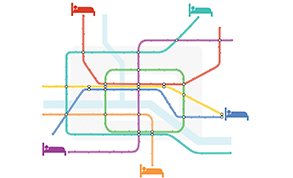Mental health: coming home
Over the past few years, there has been an outcry over the number of mental health patients – adults and children – sent far from their homes for treatment. It’s not just that this practice is at odds with the mantra of treating patients closer to home, but there is concern that without family and friends for support, patient lengths of stay are longer. This is not good for patients, and it also means the NHS is not making the most of mental health funding at a time of rising demand.
However, there is hope that the trend in placements could be reversed, thanks in part to the new priority given to mental health. The Five-year forward view for mental health, published in 2016, said the practice should be ended as soon as possible. And the recent NHS long-term plan spells out an ambition to all but eradicate placements outside a patient’s home region by 2021. Officially, the aim is to eliminate them completely, but there may be good reasons why a patient is placed far from their area, including legal rulings.
There will be support to achieve the 2021 target. The forward view for mental health programme is working with units with a long length of stay, aiming to bring the typical length of stay down to the national average of 32 days. This will increase local capacity and contribute to ending acute out-of-area placements by 2021, allowing patients to remain in their area – maintaining relationships with family, carers and friends.
It is also expected that capital investment will be made available in the forthcoming spending review to upgrade the physical environment for inpatient psychiatric care.
spending review to upgrade the physical environment for inpatient psychiatric care.
Getting it right first time (GIRFT) will look at issues around out-of-area placements for under-18s as part of its review of child and adolescent mental health services (CAMHS).
According to GIRFT, one in eight clinical commissioning groups sent an under-18 more than 320km from home in 2017/18, with one child placed 460km away.
Guy Northover, a consultant child and adolescent psychiatrist, who will be carrying out visits to CAMHS and crisis services as part of the review, says: ‘It’s not just a capacity issue – there has been a big increase in CAMHS beds over the years, and bed occupancy last year was around 72% – which means we need to look at where these beds are and how they are being utilised.’
Despite the national support, there is concern over whether the 2021 target can be reached. Data shows that the number of placements is increasing. At the end of February, 810 out-of-area placements were active, according to NHS Digital – 775 were inappropriately placed outside their region because of the lack of an available bed locally. A month earlier there were 675 active placements – 645 of which were deemed inappropriate.Upward trend
Though NHS Digital asks the figures be treated with some caution, they do appear to show an upward trend at a time when the focus is on bringing them down – in February 2018, there were 640 out-of-area placements, meaning placements have jumped more than 25% over 12 months.
During February, almost 21,000 out-of-area placement days were recorded, costing more than £10m. A look at out-of-area placements active at any point in February shows that more patients were travelling further for an inpatient bed – 335 patients travelled between 100km and 200km; 145 travelled 200km to 300km; and 45 more than 300km.
Ella Fuller, senior policy officer at NHS Providers, says the increase has been due to a rise in demand and acuity of people’s conditions. ‘The level of care and support people need at the point they are accessing that care is greater,’ she says. ‘It’s important to note that the reasons for the rise in demand are quite complex – demand has increased due to greater awareness of mental illness, for example. There is less stigma around mental illness and this is a welcome development.
‘Other factors behind rising demand are socioeconomic, but lack of beds and alternatives to hospital provision are also key factors contributing to the rise in out-of-area placements.’
In its recent report, Mental health services: addressing the care deficit, NHS Providers examined the causes in a survey of mental health trusts. It described a number of barriers to reducing out-of-area placements.
Trusts told NHS Providers the prevalence of block contracts in mental health was helping to fuel out-of-area placements. ‘They are inflexible and, once agreed, don’t reflect changes in demand in year,’ Ms Fuller says. ‘The proposed change to a more blended payment model should have a positive impact.’
A blended model would pay trusts a fixed amount linked to expected activity levels plus a volume-related amount to reflect actual activity. However, Ms Fuller warns that accurate activity baselines must be set to ensure blended payments work. ‘Given the gaps in data and lack of knowledge about unmet need, setting these baselines will be difficult, take time and is likely to require a significant resource commitment,’ she says.
Lack of capacity is creating the need for placements out of area, however the choice of services being commissioned is also an issue, she adds. ‘Out-of-area placements become more likely if the type of provision available locally is not what’s needed, so it’s important that trusts are commissioned to provide the right types of services.’
Workforce roadmap
As with most NHS services, workforce can limit the capacity to provide mental healthcare. In 2017, Health Education England set out a high-level road map to increase the mental health workforce in Stepping forward to 2020/21. By that financial year, it said, the NHS in England will employ a further 19,000 staff, many in community-based teams.
Increasing the workforce to the required levels will be a huge ask, Ms Fuller says. More community-based teams will increase capacity – preventing admissions and taking patients out of hospital when they are ready to step down. However, resourcing them adequately will be a challenge.
Around three years ago, with demand and costs escalating, NHS England decided a different approach was needed to the commissioning of specialist mental health services. It set out to test new care models in tertiary mental healthcare, with the aim of reducing out-of-area placements and lengths of stay to make sure people get the support they need as close to home, their family and friends as possible.
There were six sites when the programme went live in April 2017 – four adult medium and low secure mental health services, and two CAMHS tier four (inpatients) – with a further wave joining in 2018.
NHS England says feedback from the sites is promising, with more than 257 patients brought back into care in their home area in 2017/18. In the same period, length of stay and median distance from home have both reduced, particularly in CAMHS. As a result, a total of £10.7m was released for reinvestment in local mental health services in 2017/18.
Devon Partnership NHS Trust is the lead provider for South West Regional Secure Services – the wave one adult medium and low secure new care model pilot, which launched in April 2017. The trust is leading a significant clinically led programme to transform the way in which adult medium and low secure services across the South West of England are commissioned. The trust leads a partnership of eight providers – five NHS, two from the independent sector, and one community interest company. Its geography is across 22,000 sq km and a population of five million, with a budget of £70m.
‘Prior to the pilot going live the region had 380 patients in low and medium secure services, but more than half were placed outside the South West, with care costing between £175,000 and £250,000 a year each,’ says programme director Anne Forbes.
‘Those who were out of region had extended lengths of stay – up to double of those in-region – and only 20% of the women needing care were receiving it in region, which demonstrated the urgent need to commission appropriate services within the South West.’
This pilot enabled a key change in the way commissioning is led. NHS England devolved responsibility for commissioning to the lead provider, allowing it to address local needs, including repatriation. ‘We are now commissioning on a population basis – we are responsible for the population regardless of where they are placed in the country and have started bringing people closer to home,’ Ms Forbes says.
Positive results
Ms Fuller agrees the shift to provider commissioning of specialist services has made a positive impact. ‘We are already seeing examples of new care models for eating disorder services substantially reducing out-of-area placements, for example. New care models have the potential to make a difference – by allowing more flexibility on what can be offered, earlier intervention to prevent escalation and movement between tiers of provision. But providers need to be properly resourced to undertake these extra responsibilities.’
In the South West, an extra 78 beds were commissioned locally, within existing resources, and existing beds used more fully. And a new community forensic team has been established to work with individuals in the community, ensuring safe, earlier discharge.
The South West New Care Model pilot has won two national awards during the past year, including the HFMA Innovation Award 2018. Judges were impressed by the level of clinical and financial collaboration shown, together with an approach that spanned providers and the whole population. In two years, the region has repatriated 107 patients and reduced lengths of stay – with a closer connection to their local care teams, families and friends.
Jason Fee, the programme’s clinical director, says: ‘One person we repatriated was 100 miles from home and we brought him back into care in the South West, after four years living in a secure unit out of area. Ever since, his family has been able to visit on a weekly basis, rather than a few times a year, and he’s been engaging well in therapy sessions and started going out into the community with them, to places like the local college and library.
‘The difference in him has been remarkable. He’s got more hope and can visualise a future in his own community.’
The number of women treated in region has increased from just over 20% to more than 50%. Ms Forbes says the service changes and subsequent savings came at the right time for the region as they coincided with an increase in admissions from prisons. ‘We’ve been able to manage this because we made the savings from the new care model. Over two years, we made clinical efficiency savings of about £15m, but our cost pressures were £16m. At its peak, our admissions from prisons tripled the historic levels, but the extra costs were absorbed by the savings. But the most important thing is that demand for services has been met.’
Despite the positive work nationally, concerns remain over the ability of NHS mental healthcare providers to achieve the 2021 target.
‘Providers are committed to reducing the number of out-of-area placements,’ Ms Fuller says. ‘However, eradicating placements by 2021 is a big ask and will need the right investment, particularly in community mental health teams and the wider workforce. Making sure the other approaches to reducing demand are in place and working is also crucial.
‘Greater investment in mental health is welcome but a lot of the focus is on specific programmes rather than investment in broad provision. The long-term plan is an ambitious programme. There is concern about how many commitments can be delivered, and how fast, given the scale of the challenge.
‘A clear implementation plan will be really important so that trust leaders can balance the transformation and new demands with managing ongoing operational challenges.’
The placement of patients with mental health needs many miles from their home can be distressing for patients, their families and friends, and the NHS is determined to challenge it. Repatriation is simply an example of a clinical decision that is good for patients, and, as a result, good for NHS finances.
Transformation model
Over the past two years, a project to transform secure mental health services in the south of England has exceeded its expectations for the number of patients repatriated to their area.
The Thames Valley and Wessex Forensic Network new care model covers secure adult mental health services in Oxfordshire, Berkshire, Hampshire and Isle of Wight, Dorset and Milton Keynes. The network is made up of NHS providers of secondary and tertiary mental health care services in these areas.
Given new care model status by NHS England, Oxford Health NHS Foundation Trust became responsible for managing the secure care budget, including holding the funds, managing expenditure and delivering services. It has introduced a revised clinical and service delivery approach, increasing the input of senior clinical leadership in accessing secure services to reduce lengths of stay and numbers of patients in placements out of the network.
The Oxford trust says that over the two years of the pilot, 49 patients have been repatriated into the network area (19 in year one and 30 in year two). ‘40% of patients recorded as placed out of network 2016/17 were supported to return closer to home. In terms of our performance, our original plan forecast between 16 to 24 patients would be repatriated over the pilot, so this is an excellent achievement credited to the good work of the network. A reduced number of out-of-area placements not only benefits patients but provides significant efficiencies for the whole system.’
The arrangements have been extended for a third year while NHS England refines new care models into the mainstream, including establishing delegated commissioning arrangements to provider networks.
Related content
This event is for those that will benefit from an overview of costing in the NHS or those new to costing and will cover why we cost and the processes.
Mindset and the neuroscience of leadership - Lunch and Learn